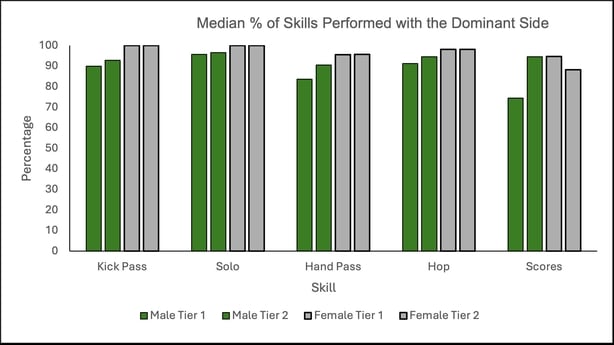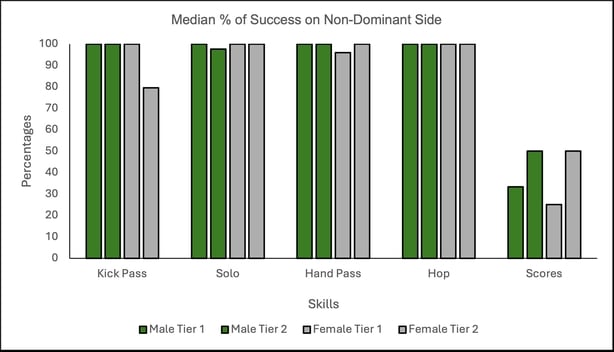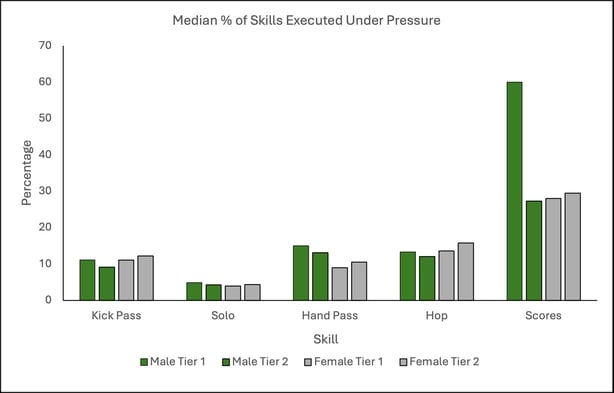Analysis: Without bilateral skills on the pitch you're going to be "left in the shop window"
The degree to which an individual can successfully perform skills with both sides of the body is termed bilateral skill and is widely is widely believed to be a key characteristic of high-level sports performers. But is this really the case? As Gaelic footballers can use the hands and feet on both sides of the body to perform an array of skills (kick pass, hand pass, solo, hop, pick up and shooting to score), Gaelic football is an ideal natural laboratory for investigating bilateral skill.
Other sports
Previous studies in soccer, via the 1998 FIFA World Cup, showed that even top players predominantly used their dominant foot for all skill executions. However, on the rare occasions players switched over to their non-dominant foot, they still had high levels of success. In basketball, the picture was slightly more complex with comparable studies in that arena concluding that players made more use of their non-dominant hand as the calibre of player increased, from amateur to professional level, especially for dribbling and lay ups.
This suggests that while strong biases in limb dominance remain even at the highest levels, non-dominant usage can be increased via practice. A notable caveat to all of this research, which we addressed in our own research, is that all players were male.
From Galway v Mayo in 2020, Shane Walsh in action (Right foot solo, right foot solo, left foot solo, right hand hop, left foot solo, right foot shot for point)
Contrasting Results
The first example of research into the aforementioned two-sidedness in Gaelic football looked at senior division one intercounty players. We interviewed 15 players and five coaches. The participants were almost unanimous on the importance and prevalence of two-sided players at this level, with one coach stating firmly that "not only in the lad’s game, but very soon in the girl’s game, without being able to use both sides of your body you are going to be left in the shop window".
Indeed, this importance of being two sided was further emphasised by another coach who recalled having "charts where top players for other teams have kicked the ball from, where they score from, heat maps whether it’s kicked off their left or right, percentages off their left, percentages on their right, videos to match that up, where you want to put these players, where they’ll score from. The level of analysis is frightening".
Although the advantage of two sidedness has mostly been considered in relation to individual performances, several players and coaches emphasised the impact this had on collective team tactics. "You would have guys with one foot and other teams knew that," one intercounty player noted. "They were letting them go down into pockets where they knew they could turn them over," he continued. "The opposition [another county team] were definitely stifling us in different parts of the pitch because they knew this guy couldn't put the ball forty yards across the field with his left leg to change the point of attack. We had two guys playing midfield who were both right footed so the opposition just completely blocked off the right-hand side."
Quantitative Study
In a follow up study, we measured two sidedness in intercounty male and female Gaelic footballers used quantifiable Performance Analysis (i.e. Coding). Teams were ranked by tiers, based on their National League positions when games took place.
Teams in Division One and Two were categorised as Tier One (Male Tier One, Female Tier One), whilst teams in Division Three and Four were categorised as Tier Two (Male Tier Two, Female Tier Two). In total, 121 games for males and females (76 male and 45 female) were coded for the kick pass, hand pass, solo, hop and shots. It must also be noted that this was the first occasion female athletes in any sport were coded or measured for two sidedness.
Results
The results of the Performance Analysis contrasted sharply with the 2022 study on player and coach perceptions on two sidedness within the game. When we reviewed the matches, we found that irrespective of players’ playing tiers or gender, intercounty players primarily used their dominant side when executing skills (see graph below), with the highest performance male players generally less reliant on their dominant limb than either lower performance male players or female players in both tiers.

However, in terms of success percentage when using the non-dominant side, similarly to the earlier research in soccer, success was high for most skills when players did use their non-dominant side (see below).

The relative lack of use, but high percentage success, of the non-dominant side may be partially explained by the fact that most skill executions took place with no opponent close enough to interfere with the action. This suggests, at first glance, a limited need to use one side of the body or the other.

However, as outlined by Dillon et al., (2022) it is short sighted to use skill success - ball retention for example - as the sole determinant that a given choice was optimal. That's because non-dominant limb use may have offered better tactical opportunities in a specific game example. In real terms the use of the non-dominant hand or foot could be the difference between releasing a teammate for a goal, or settling for a point (see Seanie O’Shea’s hand pass off his left in last year’s All Ireland semi-final against Derry to assist Gavin White’s goal).
From Kerry v Derry in 2023, Seanie O'Shea’s hand pass off his left to assist Gavin White’s goal
Ball retention and pass completion do not always equate to the correct option. Surveying opportunities, choosing the appropriate option and then executing with the appropriate limb, should be the desired order for any player. However, we often currently see players immediately going onto the dominant side and only then choosing the option which best suits them. This means the process is often backwards.
In essence, they have sometimes cut the pitch in half before they execute the skill by being so heavily reliant on one side. And in an age of blanket defences, where the aim of an attacking team is to make the pitch as wide as possible, that’s a hugely limiting starting point for the side in possession.
It’s in this context that the importance of being two sided needs to be emphasised to players, and where future research will need to be focused. Until then, do not assume every intercounty player you see is as two sided as you have been led to believe.
This research was supported by the Irish Research Council Postgraduate Award Scheme
Follow RTÉ Brainstorm on WhatsApp and Instagram for more stories and updates
The views expressed here are those of the author and do not represent or reflect the views of RTÉ




